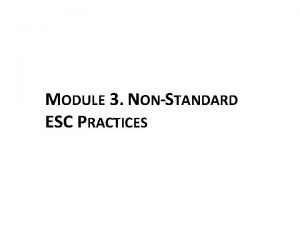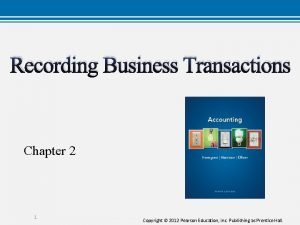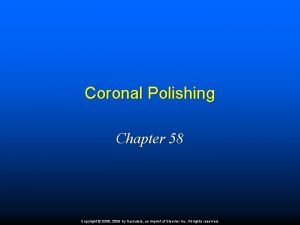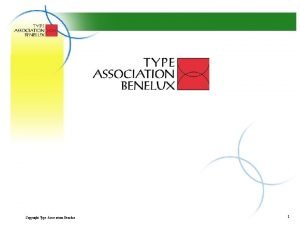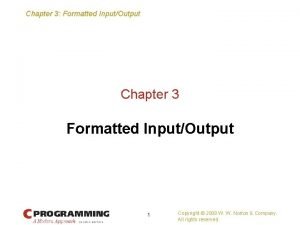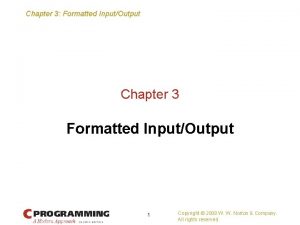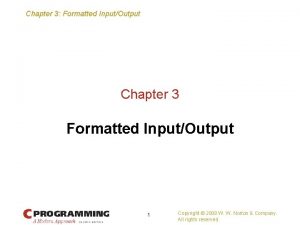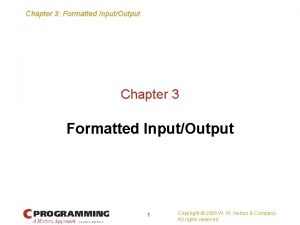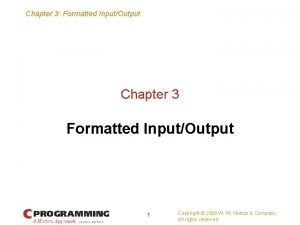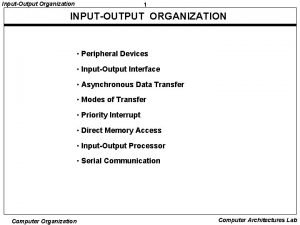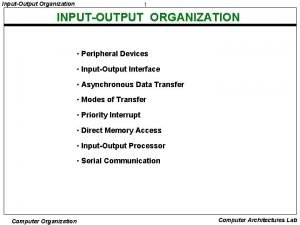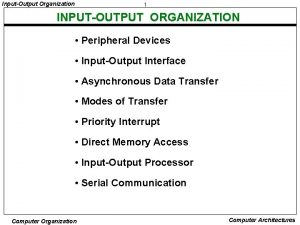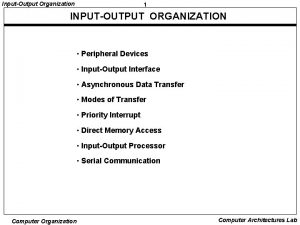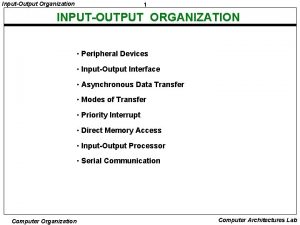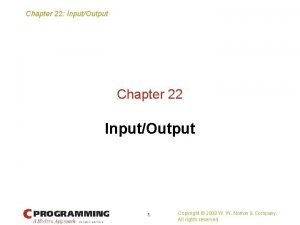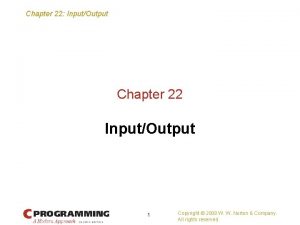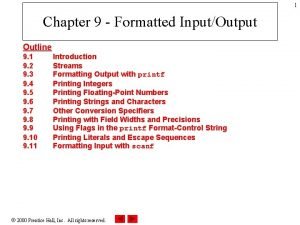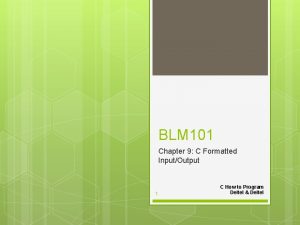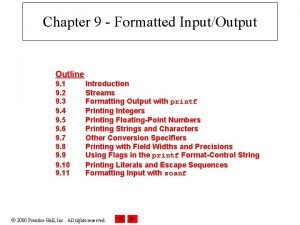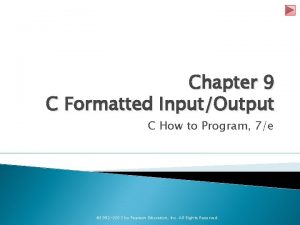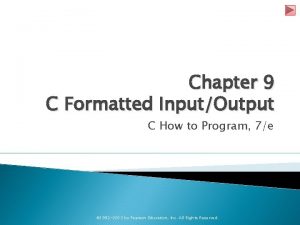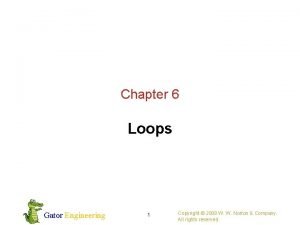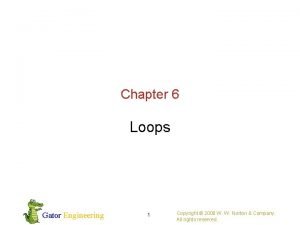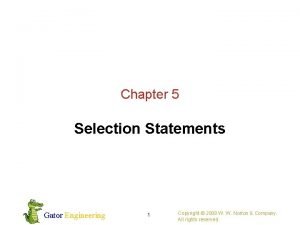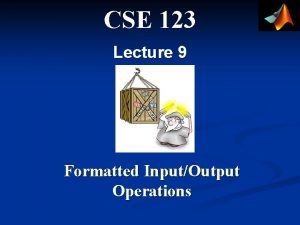Chapter 3 Formatted InputOutput Gator Engineering 1 Copyright































- Slides: 31

Chapter 3 Formatted Input/Output Gator Engineering 1 Copyright © 2008 W. W. Norton & Company. All rights reserved.

Escape Sequences • The n code that used in format strings is called an escape sequence. • Escape sequences enable strings to contain nonprinting (control) characters and characters that have a special meaning (such as "). • A partial list of escape sequences: Alert (bell) a Backspace b New line n Horizontal tab t Gator Engineering 2 Copyright © 2008 W. W. Norton & Company. All rights reserved.

Escape Sequences • A string may contain any number of escape sequences: printf("Itemt. Unitt. Purchasent. Pricet. Daten"); • Executing this statement prints a two-line heading: Item Unit Purchase Price Date Gator Engineering 3 Copyright © 2008 W. W. Norton & Company. All rights reserved.

Escape Sequences • Another common escape sequence is ", which represents the " character: printf(""Hello!""); /* prints "Hello!" */ • To print a single character, put two characters in the string: printf("\"); /* prints one character */ Gator Engineering 4 Copyright © 2008 W. W. Norton & Company. All rights reserved.

Specifiers • http: //www. cplus. com/reference/cstdio/printf/ specifier Output Example d or i Signed decimal integer 392 f Decimal floating point, lowercase 392. 65 e Scientific notation (mantissa/exponent), lowercase 3. 9265 e+2 E Scientific notation (mantissa/exponent), uppercase 3. 9265 E+2 c Character a s String of characters sample p Pointer address b 8000000 Gator Engineering 5 Copyright © 2008 W. W. Norton & Company. All rights reserved.

Confusing printf with scanf • Incorrectly assuming that scanf format strings should resemble printf format strings is another common error. • Consider the following call of scanf: scanf("%d, %d", &i, &j); – scanf will first look for an integer in the input, which it stores in the variable i. – scanf will then try to match a comma with the next input character. – If the next input character is a space, not a comma, scanf will terminate without reading a value for j. Gator Engineering 6 Copyright © 2008 W. W. Norton & Company. All rights reserved.

Program: Adding Fractions • The addfrac. c program prompts the user to enter two fractions and then displays their sum. • Sample program output: Enter first fraction: 5/6 Enter second fraction: 3/4 The sum is 38/24 Gator Engineering 7 Copyright © 2008 W. W. Norton & Company. All rights reserved.

addfrac. c /* Adds two fractions */ #include <stdio. h> int main(void) { int num 1, denom 1, num 2, denom 2, result_num, result_denom; printf("Enter first fraction: "); scanf("%d/%d", &num 1, &denom 1); printf("Enter second fraction: "); scanf("%d/%d", &num 2, &denom 2); result_num = num 1 * denom 2 + num 2 *denom 1; result_denom = denom 1 * denom 2; printf("The sum is %d/%dn", result_num, result_denom) return 0; } Gator Engineering 8 Copyright © 2008 W. W. Norton & Company. All rights reserved.

Chapter 4 Expressions Gator Engineering Copyright © 2008 W. W. Norton & Company. 9 All rights reserved.

Arithmetic Operators • C provides five binary arithmetic operators: + * / % addition subtraction multiplication division remainder • An operator is binary if it has two operands. • There also two unary arithmetic operators: + - unary plus unary minus Gator Engineering Copyright © 2008 W. W. Norton & Company. 10 All rights reserved.

Compound Assignment • Assignments that use the old value of a variable to compute its new value are common. • Example: i = i + 2; • Using the += compound assignment operator, we simply write: i += 2; /* same as i = i + 2; */ Gator Engineering Copyright © 2008 W. W. Norton & Company. 11 All rights reserved.

Compound Assignment • There are nine other compound assignment operators, including the following: -= *= /= %= • All compound assignment operators work in much the same way: v += e adds v to e, storing the result in v v -= e subtracts e from v, storing the result in v v *= e multiplies v by e, storing the result in v v /= e divides v by e, storing the result in v v %= e computes the remainder when v is divided by e, storing the result in v Gator Engineering Copyright © 2008 W. W. Norton & Company. 12 All rights reserved.

Compound Assignment • v += e isn’t “equivalent” to v = v + e. • One problem is operator precedence: i *= j + k isn’t the same as i = i * j + k. • There also rare cases in which v += e differs from v = v + e because v itself has a side effect. • Similar remarks apply to the other compound assignment operators. Gator Engineering Copyright © 2008 W. W. Norton & Company. 13 All rights reserved.

Increment and Decrement Operators • C provides special ++ (increment) and -- (decrement) operators. • The ++ operator adds 1 to its operand. The -- operator subtracts 1. • The increment and decrement operators are tricky to use: – They can be used as prefix operators (++i and –-i) or postfix operators (i++ and i--). – They have side effects: they modify the values of their operands. Gator Engineering Copyright © 2008 W. W. Norton & Company. 14 All rights reserved.

Increment and Decrement Operators • Evaluating the expression ++i (a “pre-increment”) yields i + 1 and—as a side effect—increments i: i = 1; printf("i is %dn", ++i); /* prints "i is 2" */ printf("i is %dn", i); /* prints "i is 2" */ • Evaluating the expression i++ (a “post-increment”) produces the result i, but causes i to be incremented afterwards: i = 1; printf("i is %dn", i++); /* prints "i is 1" */ printf("i is %dn", i); /* prints "i is 2" */ Gator Engineering Copyright © 2008 W. W. Norton & Company. 15 All rights reserved.

Increment and Decrement Operators • ++i means “increment i immediately, ” while i++ means “use the old value of i for now, but increment i later. ” • How much later? The C standard doesn’t specify a precise time, but it’s safe to assume that i will be incremented before the next statement is executed. Gator Engineering Copyright © 2008 W. W. Norton & Company. 16 All rights reserved.

Increment and Decrement Operators • The -- operator has similar properties: i = 1; printf("i is %dn", --i); /* prints "i is 0" */ printf("i is %dn", i); /* prints "i is 0" */ i = 1; printf("i is %dn", i--); /* prints "i is 1" */ printf("i is %dn", i); /* prints "i is 0" */ Gator Engineering Copyright © 2008 W. W. Norton & Company. 17 All rights reserved.

Increment and Decrement Operators • When ++ or -- is used more than once in the same expression, the result can often be hard to understand. • Example: i = 1; j = 2; k = ++i + j++; The last statement is equivalent to i = i + 1; k = i + j; j = j + 1; The final values of i, j, and k are 2, 3, and 4, respectively. Gator Engineering Copyright © 2008 W. W. Norton & Company. 18 All rights reserved.

Increment and Decrement Operators • In contrast, executing the statements i = 1; j = 2; k = i++ + j++; will give i, j, and k the values 2, 3, and 3, respectively. Gator Engineering Copyright © 2008 W. W. Norton & Company. 19 All rights reserved.

Chapter 5 Selection Statements Gator Engineering 20 Copyright © 2008 W. W. Norton & Company. All rights reserved.

Statements • So far, we’ve used return statements and expression statements. • Most of C’s remaining statements fall into three categories: – Selection statements: if and switch – Iteration statements: while, do, and for – Jump statements: break, continue, and goto. (return also belongs in this category. ) • Other C statements: – Compound statement – Null statement Gator Engineering 21 Copyright © 2008 W. W. Norton & Company. All rights reserved.

Logical Expressions • Several of C’s statements must test the value of an expression to see if it is “true” or “false. ” • For example, an if statement might need to test the expression i < j; a true value would indicate that i is less than j. • In many programming languages, an expression such as i < j would have a special “Boolean” or “logical” type. • In C, a comparison such as i < j yields an integer: either 0 (false) or 1 (true). Gator Engineering 22 Copyright © 2008 W. W. Norton & Company. All rights reserved.

Relational Operators • C’s relational operators: < > <= >= less than greater than less than or equal to greater than or equal to • These operators produce 0 (false) or 1 (true) when used in expressions. • The relational operators can be used to compare integers and floating-point numbers, with operands of mixed types allowed. Gator Engineering 23 Copyright © 2008 W. W. Norton & Company. All rights reserved.

Relational Operators • The precedence of the relational operators is lower than that of the arithmetic operators. – For example, i + j < k - 1 means (i + j) < (k - 1). • The relational operators are left associative. Gator Engineering 24 Copyright © 2008 W. W. Norton & Company. All rights reserved.

Relational Operators • The expression i < j < k is legal, but does not test whether j lies between i and k. • Since the < operator is left associative, this expression is equivalent to (i < j) < k The 1 or 0 produced by i < j is then compared to k. • The correct expression is i < j && j < k. Gator Engineering 25 Copyright © 2008 W. W. Norton & Company. All rights reserved.

Equality Operators • C provides two equality operators: == equal to != not equal to • The equality operators are left associative and produce either 0 (false) or 1 (true) as their result. • The equality operators have lower precedence than the relational operators, so the expression i < j == j < k is equivalent to (i < j) == (j < k) Gator Engineering 26 Copyright © 2008 W. W. Norton & Company. All rights reserved.

Logical Operators • More complicated logical expressions can be built from simpler ones by using the logical operators: ! logical negation && logical and || logical or • The ! operator is unary, while && and || are binary. • The logical operators produce 0 or 1 as their result. • The logical operators treat any nonzero operand as a true value and any zero operand as a false value. Gator Engineering 27 Copyright © 2008 W. W. Norton & Company. All rights reserved.

Logical Operators • Behavior of the logical operators: !expr has the value 1 if expr has the value 0. expr 1 && expr 2 has the value 1 if the values of expr 1 and expr 2 are both nonzero. expr 1 || expr 2 has the value 1 if either expr 1 or expr 2 (or both) has a nonzero value. • In all other cases, these operators produce the value 0. Gator Engineering 28 Copyright © 2008 W. W. Norton & Company. All rights reserved.

Logical Operators • Both && and || perform “short-circuit” evaluation: they first evaluate the left operand, then the right one. • If the value of the expression can be deduced from the left operand alone, the right operand isn’t evaluated. • Example: (i != 0) && (j / i > 0) (i != 0) is evaluated first. If i isn’t equal to 0, then (j / i > 0) is evaluated. • If i is 0, the entire expression must be false, so there’s no need to evaluate (j / i > 0). Without short-circuit evaluation, division by zero would have occurred. Gator Engineering 29 Copyright © 2008 W. W. Norton & Company. All rights reserved.

Logical Operators • Thanks to the short-circuit nature of the && and || operators, side effects in logical expressions may not always occur. • Example: i > 0 && ++j > 0 If i > 0 is false, then ++j > 0 is not evaluated, so j isn’t incremented. • The problem can be fixed by changing the condition to ++j > 0 && i > 0 or, even better, by incrementing j separately. Gator Engineering 30 Copyright © 2008 W. W. Norton & Company. All rights reserved.

Logical Operators • The ! operator has the same precedence as the unary plus and minus operators. • The precedence of && and || is lower than that of the relational and equality operators. – For example, i < j && k == m means (i < j) && (k == m). • The ! operator is right associative; && and || are left associative. Gator Engineering 31 Copyright © 2008 W. W. Norton & Company. All rights reserved.
 Inputoutput devices
Inputoutput devices Apa format for title page
Apa format for title page Snmp model in computer networks
Snmp model in computer networks Greta clasen
Greta clasen Gator blue color
Gator blue color Gator bc gov
Gator bc gov Gator grad care
Gator grad care Gator careerlink
Gator careerlink Dura wattle
Dura wattle Broward county gator club
Broward county gator club Gator robotics
Gator robotics What is system design in software engineering
What is system design in software engineering Forward engineering and reverse engineering
Forward engineering and reverse engineering Dicapine
Dicapine Engineering elegant systems: theory of systems engineering
Engineering elegant systems: theory of systems engineering Reverse engineering vs forward engineering
Reverse engineering vs forward engineering Electronic copyright office login
Electronic copyright office login Tmg copyright
Tmg copyright Copyright houghton mifflin company
Copyright houghton mifflin company The hunger games copyright
The hunger games copyright Copyright is debit or credit in trial balance
Copyright is debit or credit in trial balance Copyright 2015 all rights reserved
Copyright 2015 all rights reserved Population growth factors
Population growth factors Nist フレームワーク
Nist フレームワーク Copyright 2008
Copyright 2008 Trademark and trade secret
Trademark and trade secret Proper netiquette practices to avoid copyright issues
Proper netiquette practices to avoid copyright issues Geographic distribution of species evolution
Geographic distribution of species evolution Encyclopedia britannica copyright
Encyclopedia britannica copyright Illium
Illium Chapter 58 coronal polishing
Chapter 58 coronal polishing Mbti copyright
Mbti copyright








